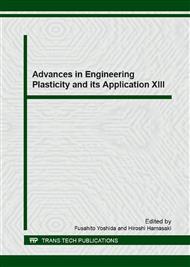p.334
p.339
p.345
p.351
p.359
p.366
p.372
p.378
p.383
On the Choice of the Power Law Flow Rule and its Consequences in Crystal Plasticity
Abstract:
Three types of power law flow rules are commonly used in classical crystal plasticity. These laws are purely phenomenological. The foremost point is how to define operative or effective stress and drag or slip system resistance. Specific choice of the definition leads to a unique number of implications including lattice rotation and slip activities, and we will highlight a few of them. We examined these three flow rules within finite strain framework with a single crystalline Al-rich TiAl binary alloy at very high homologous temperature with three strain rate controlled experimental data . It is revealed that two internal variables based flow rules give better results with a wide variety of applicability in plasticity and related phenomena.
Info:
Periodical:
Pages:
359-365
Citation:
Online since:
December 2016
Authors:
Keywords:
Price:
Сopyright:
© 2017 Trans Tech Publications Ltd. All Rights Reserved
Share:
Citation:


